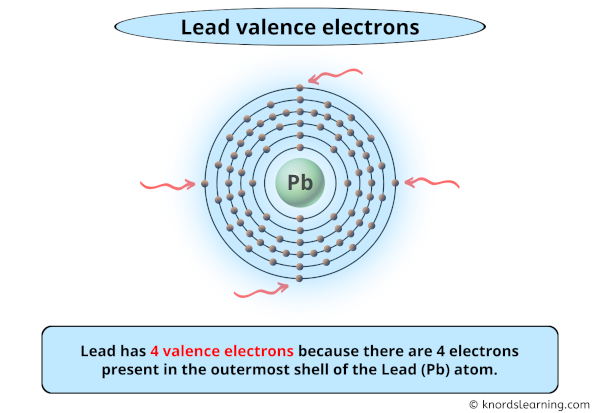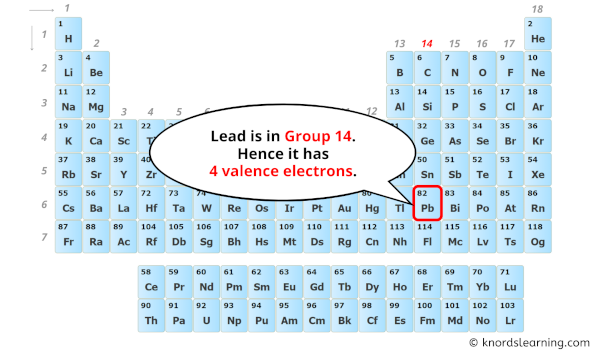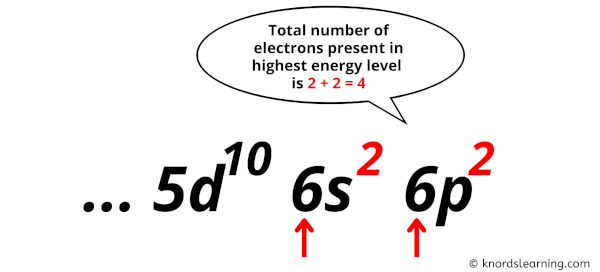
So you have seen the above image by now, right?
Awesome! You can see that lead has 4 valence electrons.
But how can you say that Lead has 4 valence electrons
+
How can you find these valence electrons?
Let’s discuss this in short.
Lead has 4 valence electrons because there are 4 electrons present in the outermost shell of the Lead (Pb) atom.
Now let’s see how you can easily find the valence electrons of Lead atom (Pb).
You can also refer to this video for finding the valence electrons of any elements.
How to find the Valence Electrons? (2 Methods)
In order to find the valence electrons of Lead atom (Pb), you can use two methods.
Method 1: From the Periodic Table

To find out the valence electrons of Lead, you have to see the position of lead in the periodic table.
More specifically, you have to see the group wise position of Lead element in the periodic table.
From the above image, you can see that the Lead (Pb) is present in the group 14 of periodic table.
(Note: Group 14 is also called group 4A).
So, as the lead element is present in group 14, it has 4 valence electrons.
In this way, by knowing the position of lead element in periodic table, you can easily find its valence electrons.
Now let’s see another method for finding the number of valence electrons in lead.
Method 2: From the Electron Configuration
If you want to find the valence electrons of lead from its electron configuration, then you should know its electron configuration first.
Now there are many methods to write the electron configurations, but here I will show you the easiest method, i.e by using Aufbau principle.
Aufbau principle: The Aufbau principle simply states that the orbitals with the lower energy are filled first and then the orbitals with higher energy levels are filled.

According to the Aufbau principle, the orbitals are filled in the following order:
1s, 2s, 2p, 3s, 3p, 4s, 3d, 4p, 5s, 4d, 5p, 6s, 4f, 5d, 6p, 7s, 5f, 6d, 7p, and so on.
Also the maximum number of electrons that can be accommodated in s, p, d & f orbitals are mentioned in the below table.
| Orbitals | Maximum capacity of electrons [1] |
| s | 2 |
| p | 6 |
| d | 10 |
| f | 14 |
Now let’s try to find the electron configuration of Lead by using the Aufbau principle.
Electron Configuration of Lead:
Follow the steps mentioned below to get the electron configuration of Lead.
- To write the electron configuration of lead, we should first know the total number of electrons present in a lead atom.
- The lead atom has a total of 82 electrons because its atomic number is 82 and it is a neutral atom. [2]
- Now we have to fill these 82 electrons in the atomic orbitals according to the Aufbau principle.
- According to the Aufbau principle, the electrons will be filled first in 1s orbital, then in 2s orbital, then in 2p orbital, and so on…
- So from the Aufbau principle, we can get the electron configuration of the lead atom as 1s2 2s2 2p6 3s2 3p6 3d10 4s2 4p6 4d10 5s2 5p6 4f14 5d10 6s2 6p2. [3]
Now in this electron configuration of lead, we have to see the total number of electrons present in the highest energy level.

You can see in the electron configuration of lead (1s2 2s2 2p6 3s2 3p6 3d10 4s2 4p6 4d10 5s2 5p6 4f14 5d10 6s2 6p2) that the highest energy level is 6. And the total number of electrons present in this energy level is 2 + 2 = 4.
So by knowing the electron configuration, we have found that the Lead has 4 valence electrons.
I hope you have understood the methods of finding the valence electrons in lead.
See more related topics for your practice;
Bismuth Valence Electrons
Polonium Valence Electrons
Astatine Valence Electrons
Radon Valence Electrons
Hydrogen Valence Electrons
Jay is an educator and has helped more than 100,000 students in their studies by providing simple and easy explanations on different science-related topics. With a desire to make learning accessible for everyone, he founded Knords Learning, an online learning platform that provides students with easily understandable explanations.
Read more about our Editorial process.
